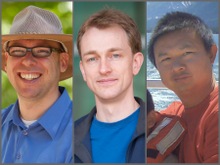Three scientists at the SLAC National Accelerator Laboratory will receive Early Career Research Program grants from the U.S. Department of Energy for research to boost the peak power of X-ray laser pulses, model catalytic chemical reactions and build better simulations of particle collisions at CERN’s Large Hadron Collider.
SLAC’s THOMAS BLIGAARD, STEFAN HOECHE and JUHAO WU were among 61 scientists selected from a pool of 770 applicants for the five-year grants, which were announced last week by the DOE Office of Science. Researchers receive about $500,000 per year for salary and research expenses.
The grants support the development of individual research programs of scientists who received their doctoral degrees up to 10 years earlier. Recipients must be full-time DOE national laboratory employees or tenure-track assistant or associate professors at a U.S. academic institution, and their research topics must fall within one of six Office of Science focus areas.
Bligaard, a senior staff scientist who joined SLAC’s SUNCAT Center for Interface Science and Catalysis two years ago, works to improve computer modeling of chemical reactions involving catalysts. Catalysts speed up reactions without themselves being consumed in the process. They are essential for many industrial processes, including the large-scale production of fuels and other chemicals, and for reducing airborne pollutants.
The grant will be useful in constructing more sophisticated, comprehensive codes that encompass a broader range of variables in chemical reactions and better represent complex materials, he said.
Hoeche, a member of SLAC’s Particle Physics Theory Group, is also working on better simulations, but of a very different sort. He and his group are developing more precise simulations for researchers at the Large Hadron Collider.
“We’re providing a tool that bridges the gap between theory and experiment,” Hoeche said.
Wu, a staff scientist in the Accelerator Research Division who joined SLAC in 2002, is studying methods to increase the peak power of pulses at SLAC’s Linac Coherent Light Source (LCLS) by more efficiently transforming its electron energy into X-rays. The LCLS is an X-ray free-electron laser, or XFEL, and its ultrabright, ultrashort X-ray laser pulses are generated when an electron beam from the lab’s linear accelerator traverses a sequence of alternating magnets in devices called undulators.
Read the entire press release on the SLAC National Accelerator Laboratory website.
